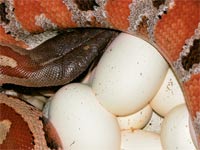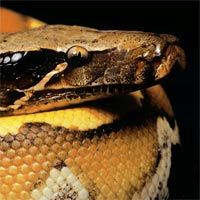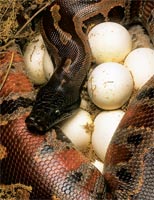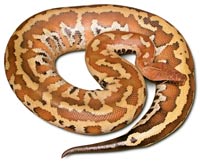Everything you need to know about the blood python.
Blood pythons are today increasingly popular snakes. They are easy to maintain, and they require no unusual caging or protocols. These snakes are voracious feeders at all ages. Many keepers like the size of the species — they are big but not too big. Best of all, the variation of colors and patterns seen in blood pythons are without equal among boas and pythons.
Still, many keepers today are hesitant to work with the species because of a reputation for irritability that dates far back into the history of the species in captivity. It is our experience and belief that the reputation from long ago is no longer valid.

Dave and Tracy Barker
Blood pythons are good mothers. Covering their eggs completely and occasionally tongue-flicking and inspecting them, females stay coiled around them.
.
Blood Pythons of the Past
In early 1934 at the New York Zoological Park, a recently imported blood python laid a clutch of 16 eggs while on exhibit. The exact date of the event was not noted because the snake was completely coiled around the clutch, hiding the eggs, for at least a few days before zookeepers realized what had happened. On Feb. 11, the curator, Dr. Raymond L. Ditmars, called an eminent herpetologist, Dr. G.K. Noble of the American Museum of Natural History, with news of the event.
Dr. Noble came over to the zoo that day to measure the temperatures of the brooding blood python, the eggs and the environment. Incubation and brooding behaviors were of special interest to Dr. Noble, and this event was regarded as particularly important. There was great curiosity about whether pythons were actually capable of elevating their body temperatures during the incubation period.
In fact, the results of Dr. Noble’s efforts to determine if blood pythons elevated their temperatures during brooding were equivocal. The paper he published in the 1935 volume of Copeia, the official publication of the American Society of Ichthyologists and Herpetologists, is the first published report of egg laying by the species. It is also the earliest report we are able to find of this species in captivity in the United States.
A few blood pythons were around back then. In 1947, C.B. Perkins, curator of reptiles at the San Diego Zoo, published a short article in Copeia on the longevities of snakes housed in that collection, including a blood python at his zoo since February 1936. Marlin Perkins, then curator of reptiles at the St. Louis Zoo, is cited by Clifford Pope in the 1961 classic book The Giant Snakes as having observed courtship and spur use by blood pythons at the zoo in the 1950s.

Dave and Tracy Barker
This blood python is a 6-month-old subadult.
However, from the 1940s to the 1970s blood pythons seem to be most notable by their near absence from herp publications of that period. They were rarely mentioned in zoo literature. Even popular herp books rarely, if ever, mention blood pythons.
We suspect the reasons for the blood python’s low profile during that time were twofold. First, they weren’t commonly available. Back then, shipments of live animals from Asia usually came by ship; reptiles just didn’t fare that well in extended exposure to the damp and cool conditions of the marine trade. Larger Asian python species were much more highly sought by zoos and collectors of the day, and efforts were directed towards obtaining them.
Second, the blood pythons available at that time probably had few fans. They were not as big and impressive in a zoo exhibit as, say, a reticulated python. The blood pythons were wild-collected, large adult animals — heavy, big, flat-headed pythons with an attitude. They were beautiful, but they glowered, sulked, thrashed and bit when handled. They were no one’s pets. Recent imports often refused to feed and sometimes went more than a year before taking a first meal. They rarely calmed down and settled into captivity. Even after 10 years in captivity they could be very difficult animals with which to work. By the 1970s the species had established a solid reputation as being difficult to keep and only rarely docile.

Dave and Tracy Barker
Greater numbers of people are breeding these big red snakes.
The Blood Python Renaissance
Today that reputation is changing. In the past decade, blood pythons have become one of the most popular python pets. The species exhibits a wide range of variation in normal colors and patterns; no two are alike. Even normal specimens can be spectacular. A variety of unusual appearances are bred in captivity. There are striped, hypomelanistic, ivory, axanthic and several varieties of albinos, just to name a few.
But the biggest change contributing to their rising popularity is a change of attitude. It turns out that blood pythons can be nice, docile, sweet-tempered pets. We believe the following changes in the origins of today’s captive blood pythons account for their new and improved attitudes.
It starts with how blood pythons came into captivity. Throughout the 20th century, blood pythons were a target species for the reptile skin trade in Malaysia and Sumatra. So far as we know, blood pythons were rarely, if ever, acquired specifically for the live snake trade. Over the past half-century and longer, a network of collectors, skinners and hide buyers developed. As recently as a decade ago, the annual harvest of blood python skins was in excess of 60,000.
Skinning businesses are scattered throughout the range of blood pythons. They also skin reticulated pythons, and many skin water monitors, as well. Some blood pythons brought to these businesses are sold for food to Chinese restaurants ubiquitous throughout Southeast Asia and Indonesia. Blood pythons also are purchased for folk medicine.
Animal dealers who visit the skin businesses rarely purchase a small number, so the main source for blood pythons before the turn of the century was the skin trade. These animals were not cared for in the same way as snakes collected specifically for the live animal trade.

Dave and Tracy Barker
This big female is a good-looking example of the black-headed dark red morph, one of several appearances considered to be normal.
The skin trade selects large adults — the bigger the snake, the more valuable the hide. Even though blood pythons could be purchased from Thai or Malaysian animal dealers for very little money back in the 1970s, the adult sizes of the available animals made shipping an expensive proposition. That’s another reason why only small numbers were imported.
It’s also a fact that baby blood pythons are almost never encountered in the wild. Thirty years ago, it became apparent to animal dealers that there was a market for young blood pythons, but they just weren’t available. Apparently they are more secretive than the adults, or perhaps they have a different habitat preference.
Then there is the geographic origin of the bloods in the live animal trade. Before 1985, live blood pythons imported to the United States came from Western Malaysia and southwestern Thailand. This area is known as the Malay Peninsula, and the blood pythons from there are best identified as either Malayan blood python or mainland blood pythons. Both countries ceased most commercial exports of live pythons by the early 1980s. In the late 1980s, Indonesia began exporting pythons, and blood pythons from Sumatra were among the first species to come out of there. These blood pythons, the same species as the Malayan blood pythons, are usually identified as Sumatran blood pythons. They, too, came from skinning businesses.
When we first became acquainted with blood pythons in the early 1970s, the only available animals had Malayan origins. Since 1990 we have kept many from Sumatra. Comparing the two, it’s our observation the Malayan blood pythons generally are not as amiable as the Sumatran blood pythons.
It’s not a hard and fast rule. We have seen very nice and trustworthy Malayan animals, but even captive-bred babies generally are not as laid-back and trustworthy as the Sumatran specimens. Only rarely did a wild-caught, adult Malayan blood python ever settle into captivity to the point where it would allow itself to be handled by its keeper. In contrast, many Sumatran adults are friendly right away, and most calm down in the first six months to become easy animals with which to work.

Dave and Tracy Barker
The pattern of this animal is typical of the matrix morph, the heterozygous condition of the ivory trait. This particular blood python has a red head, a separate and also inheritable trait.
But the biggest single factor responsible for creating the new blood python is the availability of babies. There are two main sources. Blood python collectors and also several skinning businesses in Sumatra now keep obviously gravid females, letting them lay their eggs and brood them until hatching. The majority of live blood pythons exported from Indonesia today are babies.
The other source is captive-bred blood pythons. Greater numbers of people are breeding these big red snakes. The maintenance of the species and the techniques used to breed them don’t vary much from those used to breed the more familiar Burmese python.
Blood pythons hatched in captivity thrive. They like their keepers. They feed voraciously. The bigger they get, the prettier they get. For many keepers interested in larger species, a blood python is the perfect snake. Big enough to be impressive, they are not large enough to be dangerous to their keepers. They actually are considerably smaller than boa constrictors, another commonly kept large snake. Most adult breeding female blood pythons weigh only 10 to 15 pounds and are 4 to 5 feet in length.
Think about it — most pythons are shades of brown and black. Some normal blood pythons are fire-truck red, and some of the new appearances are nearly unbelievable. If you like red snakes, why get a half-pound milk snake when you can get a 10-pound, well-mannered blood python that’s every bit as red?
It’s been interesting for us watching the metamorphosis of the blood python in captivity from the old days of the big, wild-caught Malayan animals to today’s captive-hatched and captive-bred Sumatran animals. The changes are real, not hype. Today’s blood pythons differ from the blood pythons of old.
Cage Conditions At all ages, blood pythons require a secure, well-ventilated cage. A glass aquarium with a secure, ventilated top (screen wire or perforated metal) can make a satisfactory cage for a young specimen. Plastic storage boxes with numerous perforations for ventilation also can be used to maintain blood pythons. Some of the commercially available PVC, polyethylene, ABS plastic or fiberglass cages probably best accommodate the large size and bulk of adult blood pythons.
We place hatchlings in small enclosures with about 40 square inches of floor space. We have found that often, if placed in too large an enclosure, a hatchling may be insecure and fail to feed. Once regular feeding begins, this species quickly requires more space, so we move them to cages with 180 to 300 square inches of floor space. As adults, most blood pythons require a cage with 6 to 12 square feet of floor space.
In our experience, blood pythons do extremely well on newspaper. When using this cage substrate, it is a good maintenance practice, after papering the bottom with a thick pad of newspaper, to crumple several more pieces in the cage. The snake can hide under these if it desires.
Blood pythons can be successfully maintained on a variety of substrates, including potting soil, clean gravel, cypress bark chips and carpet. However, we do not recommend any of these substrates. Over time, it is difficult to maintain clean cage conditions using them without excessive diligence.
Clean water should be available in a glass or ceramic water bowl at all times. We supply hatchlings a small water bowl measuring about 21/2 inches in diameter and 1 inch in depth. Young adults are provided a 16-ounce water bowl measuring 4 inches in diameter and 3 inches in depth. We give older specimens large ceramic water bowls measuring 8 inches in diameter and 3 inches in depth. Blood pythons drink large amounts of water, and it appears to be especially important that this python always has fresh water available.
Like many python species, blood pythons may enjoy occasional baths. However, if you choose to provide a bath, realize that a blood python may sit in water if it is stressed or insecure in its cage (it is “hiding” in its water), or if it is plagued by snake mites. Always consider these possibilities when pythons are observed continually soaking.
Blood pythons seem to do best if kept in the low to mid-80s (degrees Fahrenheit). We keep most of our blood pythons at 80 to 82 degrees in the day and 78 to 80 degrees at night. Most of the time our blood pythons do not have a basking spot available to them. When we do provide a heated basking spot, it is 86 to 88 degrees.
If recently fed, blood pythons should not be subjected to temperatures more than 90 degrees or below 78 degrees. When empty of food, blood pythons are tolerant of a wider range of temperatures. They do fine in the low 70s if they are not feeding, but we rarely expose them to temperatures below 75 degrees.
Diet
Blood pythons eat rats all their life. One appropriately sized rat per week is an adequate feeding schedule. In the fall before the breeding season, some keepers may choose to feed older and larger snakes two or three rats at each feeding. Large specimens may eat one small rabbit for a meal. Many adults will not eat during winter months.
Hatchlings start feeding on either live pink rats or live small mice (just weaned, 4 to 5 weeks old) for their first meals. Once they commence feeding regularly, most youngsters eat medium or large mice until they grow large enough to consume small adult rats. Most juvenile, subadult and adult blood pythons readily accept dead food either thawed or freshly killed.
Remember: A live rodent may attack and damage or even kill a blood python if the rodent is left unsupervised and without food in the snake’s cage.
Shedding and Humidity
A blood python generally has few problems shedding its skin if its keeper elevates the enclosure humidity one or two days before shedding occurs. We accomplish this simply by wetting the newspaper substrate. Should a snake incompletely shed, leaving a portion of the shed adhered to the snake, soak the python in shallow water for several hours. Then the adhered shed typically comes off easily.
When soaking a snake, the water should be no deeper than halfway up the side of the snake at midbody. Deeper water increases the chance of accidental drowning. Never soak a snake that is weak, sick or impaired in any way.
Small patches of skin that remain adhered to the snake are not expected to have any deleterious effect, and it is up to the keeper to arrange for the removal. It’s probably best to see that skin is not left on the face and eyes. Typically, “stuck” pieces of skin come off with the next shed. Incomplete sheds and adhered sheds indicate that the ambient cage humidity was too low during shedding. The careful keeper will tweak the system to increase the humidity from the beginning of a shed cycle until the skin is cast.
Blood python keepers have differing opinions about the optimal humidity conditions and how to achieve them. In humidity conditions below 50 to 60 percent, blood pythons have difficulty shedding, and some of the large scales on the upper surface of the snake, including the spectacles covering the eyes, may be dimpled in the center. However, in conditions of high humidity and poor ventilation, we have observed a significantly higher incidence of respiratory illnesses. In very high humidity and damp conditions, the scales prune, wrinkle and dimple. Sometimes this is misinterpreted as the dimpling caused by low humidity.
Possible negative health effects can result from a retained partial or full shed, but it is rare that shedding difficulties have serious consequences for adult snakes. However, a stuck shed that is not remedied can be fatal to hatchling or juvenile blood pythons, so the only real danger arising from keeping blood pythons in moderate levels of humidity is that novice or inattentive keepers may not realize a young snake in their care is suffering this condition.
We have found that the best course of action is to create 60 to 70 percent ambient humidity inside blood python cages with any variation toward lower humidity. In fact, this is what we consider to be about the “normal” amount of humidity present in most snake cages with open water bowls. We closely monitor our snakes’ shedding schedules, and we increase the humidity in the cage several days before a shed.
It’s been hard bucking the reputation the species made for itself, but the new blood pythons are beginning to convince even the skeptics. New to many keepers, blood pythons are replete with the variety of colors and patterns that keeps interest high. These new blood pythons are rising stars on the python scene.
When is a Blood Python a Blood Python?
The blood python is one of three closely related python species. Before 2000, all three were considered subspecies of Python curtus. In that year a paper was published that elevated each of the three subspecies to the rank of full species. The currently accepted scientific names of the three, along with our recommendations for the most concise and informative common names, are the following.
The blood python (P. brongersmai) has always been the most common of the three species in captivity. It is found in eastern Sumatra, Western Malayasia, southwestern Thailand and on some of the islands in the Strait of Malacca. It is the only one of the three that has a red morph, though it also has other appearances.
The Sumatran python (P. curtus) is found in western and southern Sumatra. Usually identified as the Sumatran short-tailed python or the black blood python, the species has occasionally and erroneously been identified as the “Sumatran blood python.” This species is the only python endemic to Sumatra, and as such, we feel the best name or it is simply Sumatran python.
The Borneo python (P. breitensteini) is found only on the island of Borneo, where it is widespread and present throughout essentially all the lower elevations. This species has been identified as both the Borneo short-tailed python and the Borneo blood python.
Special Care Tips for Hatchlings and Juveniles
Hatchlings are cute, little, pudgy babies. Most are ready feeders and easy and rewarding snakes to raise. They strongly prefer live prey for their first meals. Once they are feeding well, especially once they begin to associate food with keepers, they begin to eat pre-killed prey offered with forceps or feeding tongs. From that point, most quickly and easily switch to thawed food. Hatchlings and young snakes feed best in cages kept between 78 and 82 degrees for optimal feeding. We do not use any supplemental heat with babies.
Most pythons shed one or two weeks after hatching, but blood pythons take three or four months. Hatchlings usually begin feeding 14 to 21 days after hatching, sometimes tripling their weight by the first shed.
It’s very important to pay close attention to the shedding cycles of juveniles, and make certain that stuck sheds or incomplete sheds are quickly corrected. Unlike most pythons, where a shed skin rarely is more than an inconvenience, a stuck shed left on a baby blood python for longer than few days can result in the death of the snake. Usually, soaking the snake in 80-degree water for 30 minutes to an hour allows the stuck shed to be easily removed. Sometimes it may take overnight. We close the babies in a plastic food storage box with small holes in the lid. This box contains about half an inch of water.
Hatchling blood pythons are rarely red. The reddest adult blood pythons may start out as brown, tan or orange-brown hatchlings. Most youngsters undergo a dramatic color change as they mature. Most don’t begin to show some red in their pattern until their second year, and the brightest reds usually develop from 21/2 to 31/2 years of age. Thereafter, the red coloration of most adults may darken and intensify with age.

